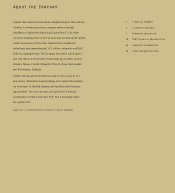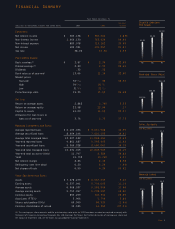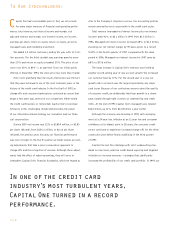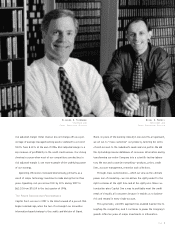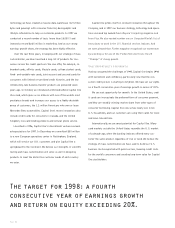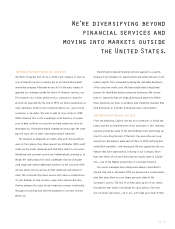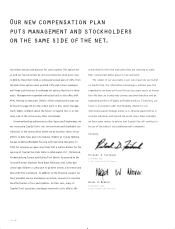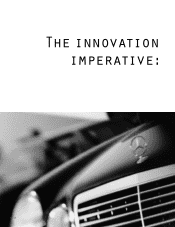Capital One 1997 Annual Report Download - page 4
Download and view the complete annual report
Please find page 4 of the 1997 Capital One annual report below. You can navigate through the pages in the report by either clicking on the pages listed below, or by using the keyword search tool below to find specific information within the annual report.
apital One had a remarkable year. In fact, we set records
for every major measure of financial and operating perfor-
mance: total revenue, net interest income and margin, risk
adjusted revenue and margin, non-interest income, net income,
earnings per share, return on assets, return on equity, accounts,
managed loans and marketing investment.
We added 3.2 million customers, ending the year with 11.7 mil-
lion accounts. For the third straight year, earnings grew by more
than 20% and return on equity exceeded 20%. The price of our
stock rose 50% to $54 3/16 at year-end. Since our initial public
offering in November 1994, the stock price has more than tripled.
Even more gratifying than the results themselves was the fact
that they were achieved in one of the most turbulent years in the
history of the credit card industry. In the first half of 1997, as
charge-offs and consumer bankruptcies continued an ascent that
began a few years ago, several of our competitors either exited
the credit card business or retrenched. Capital One’s record per-
formance in this challenging climate demonstrates the power
of our information-based strategy, our innovation and our finan-
cial conservatism.
During 1997 net income rose 22% to $189.4 million, or $2.80
per share (diluted), from $155.3 million, or $2.32 per share
(diluted), the previous year. Actually, our financial performance
was even stronger. In the fourth quarter, we made several account-
ing adjustments that take a more conservative approach to
charge-offs and the recognition of revenue. Although these adjust-
ments had the effect of reducing earnings, they will serve to
strengthen Capital One’s financial foundation, which we regard as
To Our Stockholders:
vital to the Company’s long-term success. Our accounting policies
remain among the most conservative in the credit card sector.
Total revenue (managed net interest income plus non-interest
income) grew 41% to $2.1 billion in 1997 from $1.5 billion in
1996. Managed net interest income increased 28% to $1.3 billion,
elevating our net interest margin by 95 basis points to a record
9.24% in the fourth quarter of 1997 compared with the same
period in 1996. Managed non-interest income for 1997 grew by
68% to $776 million.
The large increase in Capital One’s revenues was fueled by
another record-setting year of new account growth. We increased
our customer base by 37%. For the second year in a row, our
growth rate in accounts was the largest reported by any major
card issuer. Because of our continuing concerns about the quality
of consumer credit, we deliberately held loan growth to a slower
pace, largely through tight controls on underwriting and credit
limits. At the end of 1997, Capital One’s managed loans totaled
$14.2 billion, up 11% from $12.8 billion a year earlier.
Although the economy was booming in 1997, with unemploy-
ment at a 24-year low, inflation at an 11-year low and consumer
confidence at its highest point in 28 years, the consumer credit
sector continued to experience increased charge-offs for the third
consecutive year before finally stabilizing in the third quarter
of 1997.
Capital One met this challenge with strict underwriting stan-
dards on new loans, selective credit-based repricing and targeted
initiatives to increase revenues—strategies that significantly
increased the profitability of our credit card portfolio. In 1997, our
In one of the credit card
industry’s most turbulent years,
Capital One turned in a record
performance.
C
PAGE 2


